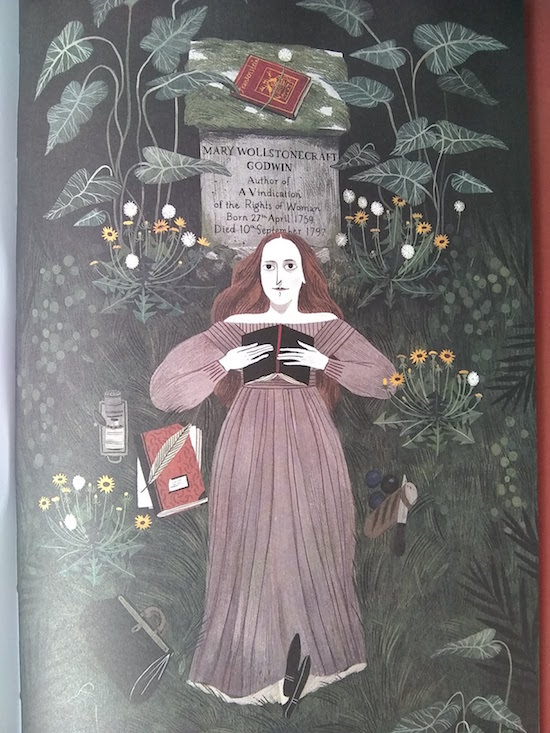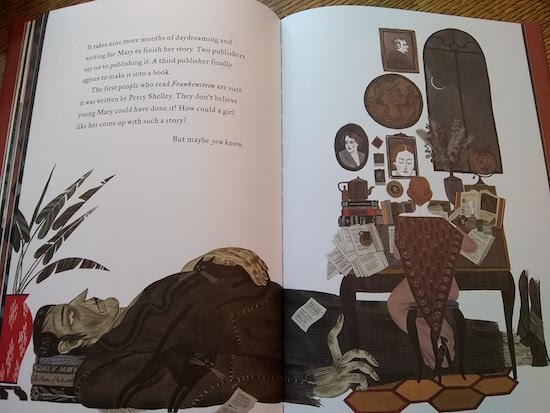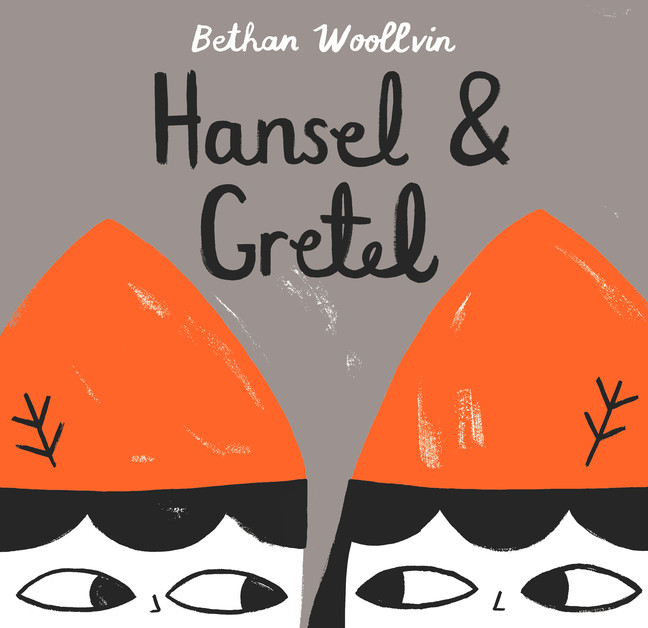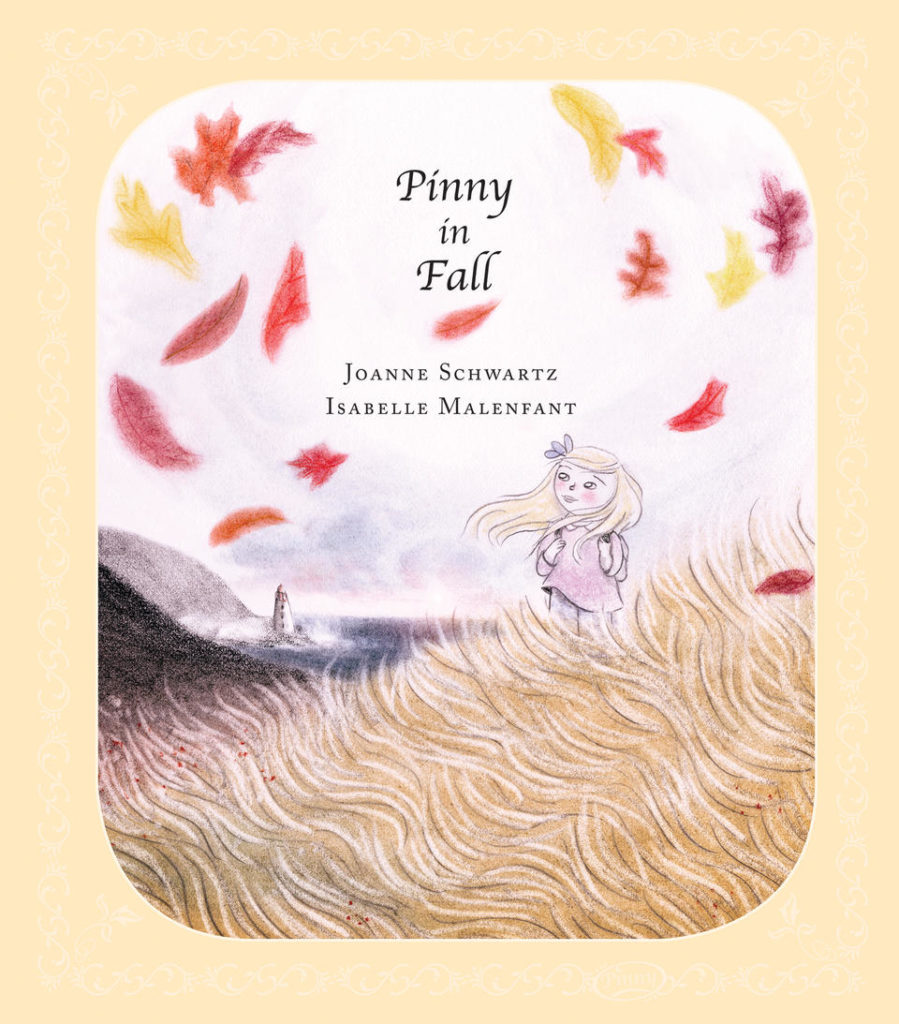September 28, 2018
Mary Who Wrote Frankenstein, by Linda Bailey and Julia Sarda

“HOW DOES A STORY BEGIN? Sometimes it begins with a dream…”
I’ve been really looking forward to Mary Who Wrote Frankenstein, by Linda Bailey, illustrated by Julia Sarda, which brings together so many of my favourite things: Sarda’s creepy/gorgeous art—she also illustrated Kyo Maclear’s The Liszts; early feminist history with references with Mary Shelley’s mother, Mary Wollstonecraft (Shelley’s father, William Godwin, would teach her to read by tracing the letters of her mother’s gravestone; the fantastic story of the creation of the Frankenstein; and also the character of Mary Shelley herself, bookish and rebellious. By the time she is a teenager, Bailey writes, Mary “has become a Big Problem,” and she’s sent to live away from her family in Scotland. “But at sixteen, when she returns to her family, she is still a Big Problem.”

“And what does she do next?” the story continues. “She becomes an even Bigger Problem. She runs away with a brilliant young poet…” In dark and brooding spreads, we see Mary Shelley and her companions travelling through Europe, meeting up with Lord Byron in Switzerland, and that dark and stormy night with the ghost story contest 200 years that has since become the stuff of legends and birthed one of the most famous stories ever told.
Throughout the story and detailed in the illustrations are all the seeds that would culminate in the Frankenstein story, intermingled with an emphasis on tales and dreamy, and steeped in a delightfully creepy aesthetic. Readers discover that powerful stories can come from unlikely places—even an eighteen-year-old girl who wasn’t sure she’d have a story to tell. We see the way that the borders between stories, dreams and life are fuzzy, and how they overlap in places—and the incredible possibilities this offers for what we can make of our lives.

September 21, 2018
Hansel & Gretel, by Bethan Woollen
Things get a bit weird in Bethan Woollen’s Hansel & Gretel, which is a book you’ve probably got to get if you’ve read her Little Red and Repunzel and you have completist tendencies. See photo below for what I’m talking about:

Once again, Woollvin is revising a fairy tale we think we know, but this time she’s telling it from a different point of view. Yes, a house made out of gingerbread might turn out to be all too tempting for a brother and sister who are lost in the woods, but luring children wasn’t what the good witch Willow had in mind when she conjured the spell to build her house. A miscalculation, maybe, but when Hansel and Gretel come tramping through the woods scattering breadcrumbs, which are sure to lure mice and other pests and therefore put Willows gingerbread house at risk, she politely asks them to clean up the crumbs, which they refuse. And when she has her back turned cleaning up the crumbs herself, the recalcitrant pair begin snacking on the house, which might be the final straw for some witches, but not this witch, who determines Hansel and Gretel must be hungry and invites them to come in for dinner.
It turns out that Hanesel and Gretel have no manners at all, however, and they gobble up all of Willow’s food, then start messing with her spells and wands, turn the black cat gigantic, and then Gretel stuffs Willow into the oven so she and her brother can continue to make trouble—but then the house is so full over magic, it explodes: “It was only made out of gingerbread after all.”
And so it is here that Willow finally decides to get her comeuppance, concocting a nasty bit of revenge that Hansel and Gretel completely had coming, and which hearkens back to a bit of fairy tale darkness worthy of Grimm’s.

September 14, 2018
Pinny in Fall, by Joanne Schwartz and Isabelle Malenfant

Before Joanne Schwartz was taking over the literary world with her beautiful picture book, illustrated by Sydney Smith, Town Is By The Sea, she was author of a whole bunch of other lovely picture books, among them the perfectly delightful Pinny in Summer, which we fell in love with two years ago and inspired us to bake a cake. And so we’ve been looking forward to Pinny’s return with Pinny in Fall, a collection of four miniature adventures that demonstrate the amazing possibilities of a single day, smallness (and slowness) writ large in an approach that reminds me of the Frog and Toad books.
“Does Pinny have parents?” my children wonder when we read this book, and I tell them that her parents are probably curled up in comfortable chairs somewhere reading. Which means that Pinny can do whatever she wants to—in the first story she wakes up and does her stretches, and then packs a small bag for her morning walk, with a sweater, a rain hat, a snack, and her book. Plus her treasure pouch, which was hanging on a hook by the door.
On her walk to the lighthouse, she encounters her pals, Annie and Lou, and they play tag in the wind and the fog, and then Pinny shares her snack and they read poetry. “The sun slipped behind the clouds, once, and then it was completely gone.” The fog is getting thicker in the third story (which Malenfant renders beautifully in her art) and Pinny and her friends have to rush to help the lighthouse keeper sound the foghorn and light the light. With their help, a ship safely navigates its way along the rocky shore, and the lighthouse keeper rewards the children: a piece of beach glass for each of them. Pinny slips hers into her treasure pouch.
And in the final story, Pinny is sipping hot chocolate by her window. As with Pinny in Summer, the colours in this book are particularly and beautifully hued, and the light that shines into Pinny’s room at the end of the day continues to be the most wonderful thing. This time coloured by the leaves falling outside her window: “A Special Kind of Rain.” After going outside to soak in it, she comes back in and the day is nearly done—her takes the beach glass from her treasure pouch and sets it on the window. “The glass had been washed so smooth by the ocean, it glowed in the twilight like a tiny bacon of light.”
Pinny in Fall is a gorgeous, old-fashioned story with such reverence for language, and wholly infused with a sense of wonder that will inspire readers to look at the world differently and seek out adventures of their own.
September 7, 2018
Ira Crumb Feels the Feelings, by Naseem Hrab and Josh Holinaty

The children went back to school this week, and nobody cried—except me when they played “We Are Going to Be Friends” on the radio, but I’m not counting that. And while there is nothing wrong with crying, that nobody did cry means that this week has been relatively smooth sailing, so far. (Lack of sleep notwithstanding. ASBWU! [Always Somebody Be Waking Up!, possibly our new family motto]) But in Naseem Hrab’s Ira Crumb Feels the Feelings, illustrated by Josh Holinaty, things are just a little more emotional…
(Psst: see Hrab’s ‘An Open Letter to the Stranger Who Asked Me, “How Did You Write That Book for Children If You Don’t Have Children?”’)
This is Hrab and Holinaty’s second book about Ira Crumb, whose best friend is Malcolm Cake, who appears to be a rabbit. And they have a good time together and indulge in extra pickles, and everything is perfect until a little rift because Malcolm wants to play tag and Ira doesn’t, and finally Ira ends up alone. And not just alone: sad and alone.
“My tummy hurts,” says Ira, in comics-inspired speech bubbles. “My chin is wobbling. My eyes are leaking. Even my feelings are having feelings.”
This is a great book about emotions and the importance of feeling your feelings, but it’s also really fun to read with lots of deadpan humour, great pace and rhythm, and an anthropomorphic fart, of curse. The latter point meaning that the children really like it, but the really important part is that their parents like it too.
June 15, 2018
The Steves, by Morag Hood

A thought that occurs to me sometimes is that there are an awful lot of Steves in general, and definitely too many Stevens in Canadian Literature (but not you, Steven, I’m talking about the other ones, unless you are that one, then I am definitely talking about you), and then yesterday I got this package in the mail, so the whole situation has definitely become alarming. Which seemed like the perfect occasion to make The Steves, by Morag Hood, my picture book Friday selection, I thought, even though Hood’s Steves are not Canadian and therefore can’t be held responsible for CanLit Steveness (but they would probably get along well with Kelly Collier’s Horse Named Steve, who has a new book out this fall called Team Steve [YAY!!!]).

Morag Hood’s Steves are puffins, naturally, each is surprised to find another Steve on his turf. “But I was here first,” declares Steve. “BY ONE PAGE,” declares Steve in a different typeface. Neither is content to let the other be Steve the First. Who is the oldest? Who is the wisest? Who is the greatest? Yes indeed, this becomes just another Steve-measuring contest. Which one is the Stevest Steve? They even turn to insults: “WEIRD FEET STEVE.” “SMELLS OF POO STEVE.” Which takes the whole thing just a step too far, and then the friends apologize, shortly before running into a third puffin, and guys, you’re never going to guess what his name is…
May 24, 2018
Turtle Pond, by James Gladstone and Karen Reczuch

Every time I go, Allan Gardens seems like a secret I’ve just been let in on, this tropical oasis in the heart of the city, even in the dead of the winter. And if Allan Gardens is a secret, then the Allan Gardens turtle pond is a treasure at the bottom of your pocket. When we go, we can linger there for ages as the waterwheel turns, counting the turtles, then counting them again, and never coming up with the same total twice. Everything they do is fascinating, and we watch them with wonder, these otherworldly creatures who are our neighbours. Eventually I wander off to check out the orchids, but my children never tire of watching the turtles in the turtle pond. And so we were all excited about Turtle Pond, by James Gladstone and Karen Reczuch, in which the magical Allan Gardens turtles finally find their way into proper legend, where they belong. For us, this story of a trip to the turtle pond is perfectly familiar, and the illustrations do a lovely job of conjuring the experience, and for those who haven’t learned the secret yet, this book is a great place to start discovering.
May 18, 2018
They Say Blue, by Jillian Tamaki

I’m in love with They Say Blue, the debut picture by Jillian Tamaki as author, although she’s an award-winning illustrator best known for Skim and This One Summer, with Mariko Tamaki. They Say Blue is an abstract story that reminds me of The Color Kittens, by Margaret Wise Brown, but with fewer kittens, the way that one thing runs into another. “They say blue is the colour of the sky,” the story begins, “which is true today!” And here we see an image of a little girl sitting on a beach. “They say the sea is blue, too. It certainly looks like it from here.” But not everything they say is true, of course, as the girl realizes when she holds water in her hands and “it’s as clear as glass.” Are blue whales blue, she wonders. “I don’t know. I’ve never seen a blue whale…but I don’t need to crack an egg to know it holds an orange yolk inside.” And then the story moves from blue, to orange, to red, and gold. “A field of grass looks like a golden ocean.” And then it’s raining, and there’s a crocus: “Oh! Could purple mean something new?” As cold turns to warm, the girl sheds her winter layers. “I stretch to the sky with my fingers open wide.” And she turns into a tree. Moving through the seasons, changes, and it’s winter again. “All white, up and down. Sometimes I can’t tell the difference between the land and sky.” She is a girl again, curled up, asleep: “Black is the colour of my hair.” And this part, which is my favourite: “My mother parts it every morning, like opening a window,” and the golden light comes in again. The story going on, as the girl and her mother watch crows out the window. “We wonder what they are thinking when they look at us. What they see….” The story’s final image is a red and orange sunset, the crows in flight. “Tiny inkblots on a sea of sky.”
This is a story about change and mutability, the possibilities of becoming, and the blurring of distinctions between one thing and another. It’s about imagination in flight, about the connections inherent between living things, between human beings and our landscapes. About questions, and wondering, and how nothing ever stands still.
And it’s absolutely stunning.
May 4, 2018
EveryBody’s Different on EveryBody Street

One of the best people I’ve ever known is Tracey, who we were all lucky enough to learn from during the years my children were enrolled at Huron Playschool and she was their teacher. She taught me all the best things I know about getting along with people, a project which is forever a work-in-progress, I know, but I find myself coming back to our conversations all the time. Our Playschool was a cooperative, so getting along with people was integral to the success of anything, but even more important was understanding and appreciating the different skills and abilities that everybody was able to bring to the table. And essentially, that there are always going to be some people who don’t do their part, who complicate processes, who made things harder for everyone else. But this too is exactly what people are, I remember Tracey telling me one day. When you sign up for a co-op/a community/a society/to be a person in the world, you don’t always get to pick your fellow travellers. The very point of everything is: it takes all sorts.

Which is the very spirit that infuses EveryBody’s Different on EverBody Street, by Sheree Fitch, illustrated by Emma Fitzgerald, a reissue of a poem Fitch published in 2001 to support a hospital charity and mental health initiatives. “If ever you go travelling/ On EveryBody Street/ You’ll see EveryBody’s/Different/ Than EveryOne you meet…”

The poem goes on to discuss how some are messy and some are neat, some grow tomatoes, and some don’t have enough to eat. “Some of us hold bags of hope/ Like babies in our arms/ Some hope over sidewalk cracks/ In search of good luck charms…” Some people are outgoing, others hold their selves inside.

“Some of us have visions/ Some of us have schemes/ Most of us have wishes/ All of us have dreams…”

And this, THIS: “All of us are perfect/ And all of us have flaws.” Which is the best two opposing ideas I’ve ever been able to hold in my head at the same time, such an important reminder to learn to accept and understand people as they are, to appreciate their unique qualities and even the ways they challenge things. Nobody’s perfect, and everyone’s perfect—what a thing. And it’s what Tracey was saying all along.
April 27, 2018
Back to the Future, by Kim Smith

When I was about seven or eight-years-old, Back to the Future was my favourite movie. Marty McFly was so unfathomably cool hitching a ride on his skateboard around town, and the movie suggested a perfectly ordered universe where there was such a thing as destiny (and density) in that mom was always going to fall in love with dad, Michael J. Fox actually invented rock and roll, and the bully wouldn’t triumph. I mean, just as long as no one disrupted the Space Time Continuum, obviously. In a perfectly ’80s anecdote, I will tell you that I once tried to install a flux capacitor (I think it was a a coat hanger) to make a time machine out of my Dukes of Hazzard Big Wheel. Sadly, it didn’t actually work, probably because I couldn’t get any plutonium.

A few months ago, I decided it was finally time for us to sit down and watch Back to the Future en famille. (“Your kids, Marty! We’ve got to do something about your kids!”) And unlike many movies that had delighted me once upon a time (The Goonies? So shrill!) Back to the Future held up perfectly. 33 years later, Marty’s suspenders/puffy vest outfit just works somehow, the Huey Lewis is fantastic, the ’80s are the future arrived at, and the jokes are still funny—remember Uncle “Jailbird” Joey and “get used to those bars, kid?” Plus, Wayne from The Wonder Years in a Davy Crockett hat.

Harriet loved Back to the Future as much as I did when I was her age, which has made the new Back to the Future picture book an especially coveted item at our house.

Part of Quirk Books’ series of nostalgic pop-culture picture books (whose titles include Buffy the Vampire Slayer, the X Files and E.T.) by Canadian illustrator Kim Smith, these books are a kids’-eye-view of the pop-classics we grew up loving. Skipping some bits—the Libyan terrorists, George McFly as a peeping tom, the whole “Calvin Klein” mix-up surrounding Lorraine and Marty’s underwear—the film’s plot is told in picture book form, right down to the Enchantment Under the Sea Dance and the disappearing photo of Marty and his siblings in front of the wishing well.

Will Marty be able to teach his dad to stand up for himself, reunite his parents, invent rock and roll, and drive his De Lorean by the Hill Valley clock tower at the precise moment that lightning strikes, by which powering his journey back to the future? Well, no spoilers here, but I’ll tell you that the story ends with Doc Brown and Marty heading off on another time travelling adventure.

“Roads? Where we’re going, we don’t need roads…”

April 20, 2018
The Bagel King, by Andrew Larsen
 We love Andrew Larsen’s new book, The Bagel King, about Eli, whose Sunday morning ritual involves his grandfather arriving with bagels fresh from the bakery. Sometimes Zaida lets Eli come with him, and Eli gets a pickle from the big jar behind the counter, but usually Zaida comes to him. With the bagels. Except one Sunday he doesn’t! Turns out Zaida slipped on some schmaltz and hurt his tuches—and one of the best parts of this book is the Yiddish glossary which means we now know how to say “tuches.” Zaida’s injury has taken the best thing out of Sunday for not only Eli, but also for Zaida’s neighbours, who’d come to rely on his bagel deliveries as well. And so the next Sunday Eli steps in to fill the gap, and it becomes apparent that the bagel kingdom is something a person can inherit. And good thing—because what’s a Sunday without bagels, Zaida asks, in this story about intergenerational relationships, family and neighbourhood connections, the importance of ritual, plus pickles and carbs. “Warm. Chewy. Salty. Bagels were the best thing about Sunday. The best thing, that is, except for Zaida.”
We love Andrew Larsen’s new book, The Bagel King, about Eli, whose Sunday morning ritual involves his grandfather arriving with bagels fresh from the bakery. Sometimes Zaida lets Eli come with him, and Eli gets a pickle from the big jar behind the counter, but usually Zaida comes to him. With the bagels. Except one Sunday he doesn’t! Turns out Zaida slipped on some schmaltz and hurt his tuches—and one of the best parts of this book is the Yiddish glossary which means we now know how to say “tuches.” Zaida’s injury has taken the best thing out of Sunday for not only Eli, but also for Zaida’s neighbours, who’d come to rely on his bagel deliveries as well. And so the next Sunday Eli steps in to fill the gap, and it becomes apparent that the bagel kingdom is something a person can inherit. And good thing—because what’s a Sunday without bagels, Zaida asks, in this story about intergenerational relationships, family and neighbourhood connections, the importance of ritual, plus pickles and carbs. “Warm. Chewy. Salty. Bagels were the best thing about Sunday. The best thing, that is, except for Zaida.”





